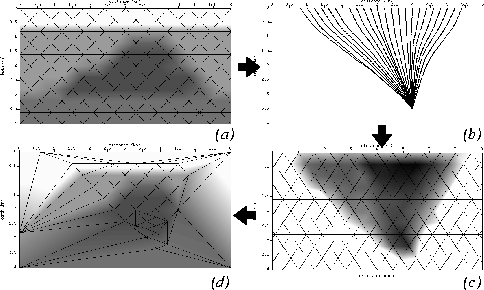




Next: A synthetic example
Up: Data dependent parameterization
Previous: Data dependent parameterization
The a posteriori covariance is an important tool to evaluate the solution of the optimization. Therefore it is useful to use it as a criteria for the adjustment of the parameterization. The covariance matrix can be calculated during optimization by (Menke, 1984):
|  |
(4) |
When least squares optimization (shown in equation (3)) is used, the first term on the right hand side corresponds to the covariance matrix, so
|  |
(5) |
The covariance matrix contains M diagonal elements that correspond to the (M) variances of the model parameters.
These elements are used to adjust the parameterization after optimization (Fig.5).
In Figure 6 an example of the use of a posteriori covariance for data dependent parameterization is shown. For the velocity model shown in Figure 6a the traveltime data corresponding to the rays in Figure 6b are available. When the a posteriori covariance matrix is calculated and the diagonal elements of the matrix (variances) are plotted for each grid-point, this results in an image as shown in Figure 6c. In this image the dark values indicate low variance and light values indicate high variance. As mentioned before, high variance grid-points are removed, and in regions containing low variance grid-points extra parameters can be added. This finally results in the data dependent parameterization shown in Figure 6d.
datadep
Figure 6 Example of data dependent parameterization.
(a) Delaunay triangulation in model defined by a regular grid.
(b) Ray-paths from a focus point at position (4.0km; 3.5km) to the surface.
(c) Variances at the grid-points in the optimization with ray-paths in (b). Dark values indicate low variance, light values indicate high variance.
(d) Adjusted parameterization based on the variances.






Next: A synthetic example
Up: Data dependent parameterization
Previous: Data dependent parameterization
Stanford Exploration Project
9/18/2001
